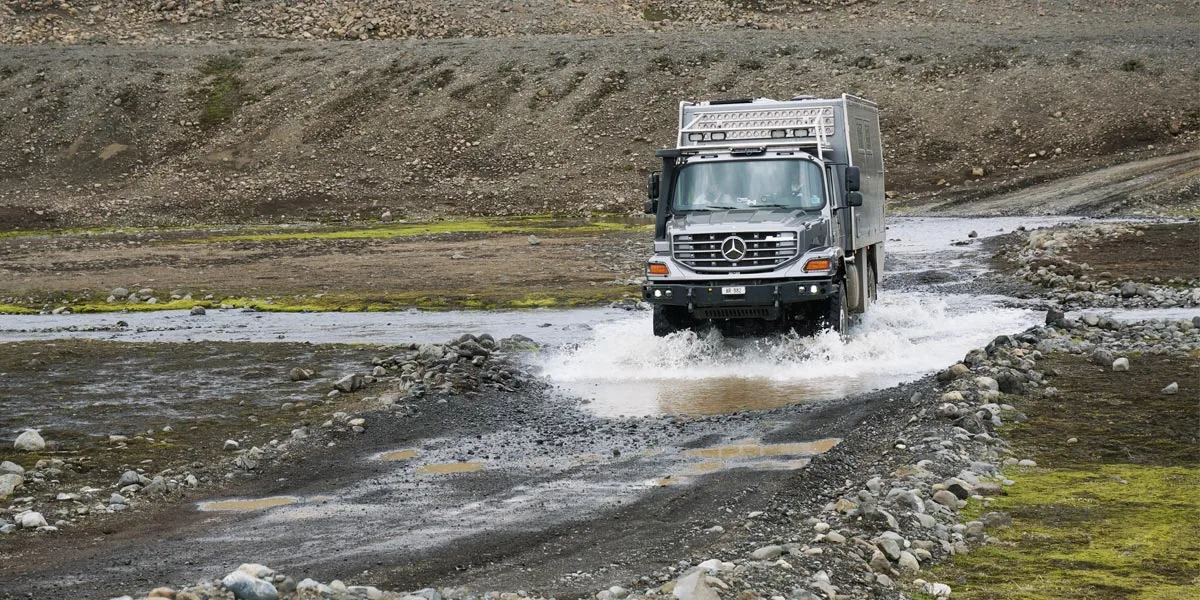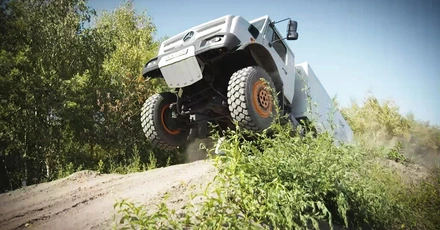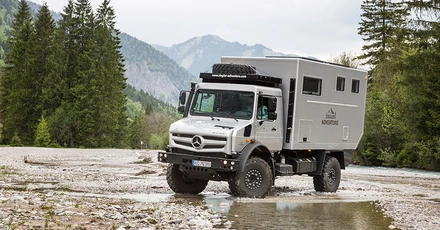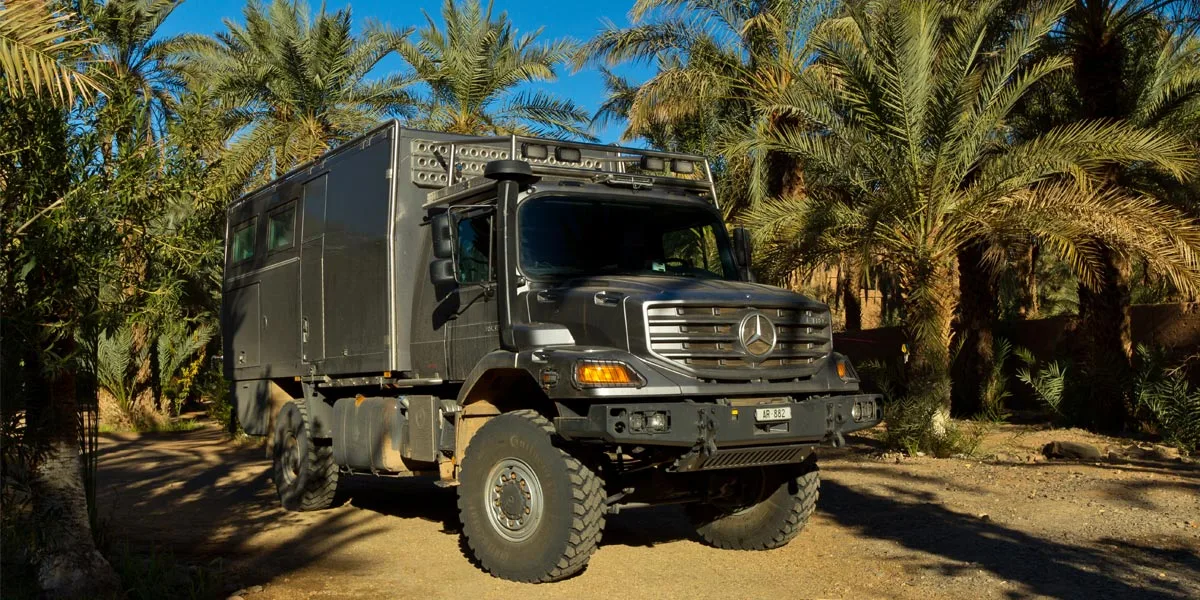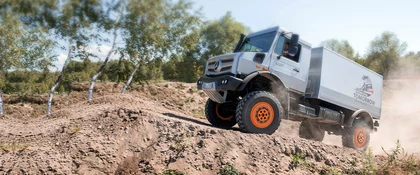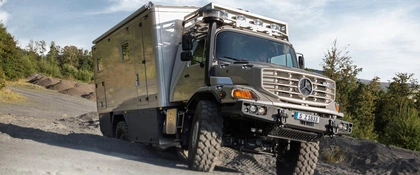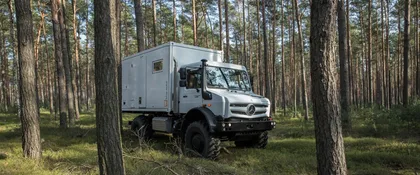The Zetros is convincing both on asphalt and off-road.
The driveline from the engine back consists of an Allison 3000P six-speed automatic transmission, which is driven through a two-speed Mercedes transfer case. Power is then sent to the front and rear wheels, with the standard on-road program sending 40% to the front and 60% to the rear wheels. Once off-road mode is selected the power is spread evenly, 1:1, between the front and rear wheels. This also engages a lower 1.69:1 ratio in the transfer case, giving much better speed control and engine braking performance. Diff locks add to the tractive power, and are easily activated from inside the cab. Suspension comes in the form of parabolic springs all round, with the three-leaf front setup rated to 9.0 tonnes, and the four-leaf rear up to 9.0 tonnes per axle (depending on wheel and tyre size). Planetary hub reduction diffs (with aforementioned diff locks) put the power to the ground through huge 14.00 R 20 tyres.
All of this is mounted to 9.5 mm thick chassis rails that provide both strength and flexibility, as was evident over the drive. The heavy-duty hardware is certainly that – heavy. In cab/chassis form, the 4x4 Zetros 1833 A weighs in at just over 8.0 tonnes, while the 6x6 2733 A tips the scales at 10.5 tonnes. This may not seem too bad to those who operate heavy-duty road train prime movers, but the Allison automatic does limit their GCM, and these trucks won’t pull 130 tonnes. A manual gearbox is available for those heavier GCM tasks though. That said, they are still easy to operate, and agile enough to get where most big dollar 4x4 wagons won’t.
While the Zetros is designed for off-road use, it is also quite driver friendly on the tarmac. The off-road driving activities for the day were planned to take place out the back of Anglesea, about an hour’s drive west of Melbourne. The hour-long drive involved freeways and some B roads, before hitting the Great Ocean Road for the last few Ks. This was a great opportunity to get acquainted with the dynamics of the Zetros, including steering and braking, before hitting the rough stuff.
Great sovereignty and high comfort.
As is common practice, the Zetros is speed limited to 100 km/h, but the gearing and my mechanical sympathy limited road speed to a maximum of 90 km/h. At this speed, the engine was working at 2000 rpm, and, while it would’ve done 100 km/h, I didn’t see the need to push any harder. The Zetros handled very well on the road, however the lack of weight on the 4x4 model made for a good demonstration of the stiffness in the rear springs. The 6x6, with a heavy tray and 4.0-tonne of concrete on the back, gave a much better ride, and, consequently, a better demonstration of handling.
Eventually the time came to select off-road mode and push our way through the trees. As we drove along the fire trails, there were a couple of places where the tracks of smaller 4x4 vehicles came to an abrupt end. One of these was a steep bank where it was clear someone had made multiple attempts to get their 4x4 to the top, but never made it. Both the 4x4 and 6x6 Zetros trucks simply walked over it like an ant hill and powered on, giving a clear demonstration of just what these trucks could do. This was one point where I was able to watch the suspension on the 6x6 really working, and the flex in the chassis. The flexibility in both components meant that all six wheels were firmly on the ground, until the rear axle lifted off as the truck levelled out at the top.
While most of the trails we covered didn’t seem to really test the Zetros, certain sections demonstrated the benefits of different aspects of their design. Ground clearance, approach angles and turning circles were all highlighted over the course of the day, with me, for one, left amazed at where these trucks went. What’s more amazing is that they did this stuff with me at the wheel, in unfamiliar territory and unfamiliar trucks, yet with great ease and comfort.
Out and about in the Australian bush.
There is no doubt that the Allison automatic had a huge impact on the ease of operation, with no break in the delivery of power during gear changes. This meant seamless power on climbs, even where gear changes were necessary, and no loss of momentum. Sure, they may have looked a little second hand after pushing their way through the scrub all day, but that’s what they’re designed to do, right?
The Zetros is fighting for a part in a niche market where buyers really do buy on necessity, not looks (which I happen to like anyway). While I have driven a few competitors before, none of them would have fitted in a Hercules freight plane. All jokes aside, most other models in the off-road market use a cabover design, and, while the difference may be minimal, the experience in a bonneted truck is totally different. Not only is there that protection out in front, from low hanging trees and such, but the improved ride and lower noise levels make life much easier on a driver.
While it has been common knowledge for some time that Mercedes has been building the Zetros, there has always been a perception, in Australia at least, that it was solely for military purposes. Make no mistake, the Zetros is capable, the service and backup is available, and you can buy one from any Mercedes Benz truck dealer across the country. Whether you’re after a fire truck, a water cart or an off-road camper, the Zetros is well worth a look.
